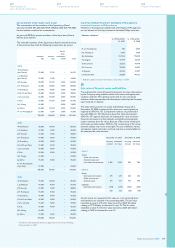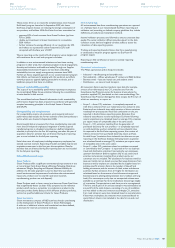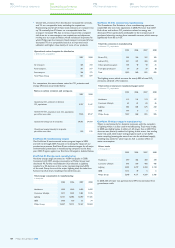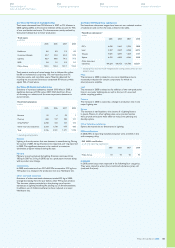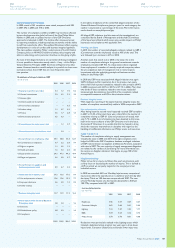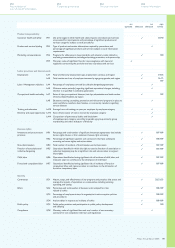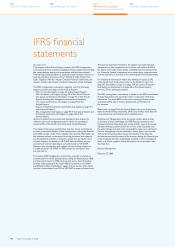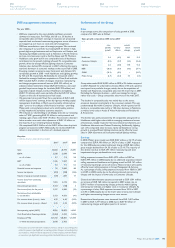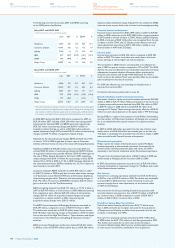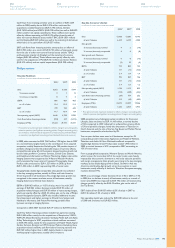Philips 2008 Annual Report Download - page 186
Download and view the complete annual report
Please find page 186 of the 2008 Philips annual report below. You can navigate through the pages in the report by either clicking on the pages listed below, or by using the keyword search tool below to find specific information within the annual report.
As we move forward with our D&I initiative, new targets are being
set to be achieved by 2012. More detailed attention will be given to
growth markets and to increasing the numbers for top potential and
executive positions. As a result we will focus on target setting for
the BRIC countries, to monitor progress more closely.
Developing our people
Employees across the world can access detailed information about
our Global Learning Curricula and register for courses online via
our Global Learning Portal, Learning @ Philips.
number of employees participating
2005 2006 2007 2008
Core Curriculum programs 11,000 14,500 12,000 10,000
Our Core Curriculum offers learning opportunities in the areas of
personal effectiveness, people management and business acumen.
With nearly 10,000 employees participating in programs in the Core
Curriculum during 2008, enrollment decreased compared with 12,000
the previous year.These decreases are a result of travel restrictions.
Our Functional Core Curricula includes courses in Finance, HRM, IT,
Sales, Marketing, Project Management and Supply Management.
Enrollment in the Functional Core Curricula was some 7,600 in 2008,
a slight decrease from 8,000 in 2007. Many Functional Curricula are
tied to mandatory learning plans designed to increase our
organizational capability.
Talent pipeline curriculum
The Talent Pipeline Curriculum consists of systematic, accelerating
and inspiring learning interventions for the Philips talent pool (from
high potentials to executives).
Our advanced learning experience for high potentials, called Inspire, is
designed to develop future leaders who are able to combine a thorough
understanding of their business environment with excellent personal
skills. The Octagon program is the accelerating development program
for top potentials, offering participants the opportunity to use the
strategic insight, knowledge and skills required to tackle a major
(cross-sector/cross-regional/cross-functional) issue, and round out
their Philips leadership behavior.
We upgraded the content of our Inspire program to stretch even
further the development of our high potentials. In 2008, the Inspire
program facilitated completion of seven project assignments, with seven
more expected to be completed. One project explored potential
business opportunities for consumers to move towards a more
sustainable lifestyle by focusing on developed and emerging markets.
Eight Octagon projects were completed. The first class of 2008
showed the highest results in the past four years in quality and Net
Promoter Score as measured by participants’ evaluations. One of the
projects the top potentials worked on looked at how to bring lighting
devices into rural villages in India where electricity is not available.
Executive education
To help our executives to continue to develop their careers and
strengthen their leadership skills, we have been offering a curriculum
of internal and external programs. These offerings continue to be
relevant to our executives. Participation remained at the same levels
as 2007, with approximately 9% of executives and top potentials
attending external business school programs.
After the 2007 redesign of our executive induction program for
newly hired or recently appointed executives, results continue to
show high quality levels for participants. In 2008, 13 new executives
went through the session.
People Leadership Index
Because managers contribute significantly to the engagement of their
employees, we have developed the People Leadership Index (PLI),
which focuses on overall people leadership effectiveness. Our PLI –
measuring 10 aspects relating to management capabilities – continued
to increase, rising to 69% in 2008 from 64% in 2007. This is encouraging,
as it shows that our efforts to improve our managers’ leadership skills
are working.
Social indicators
Engagement
In 2008, 90% of Philips employees took the Engagement Survey,
giving their answers to 44 questions on leadership, management
capabilities, alignment with the company’s vision, identification with
the brand, communication, reward and recognition, diversity and
inclusion, and sustainability.
Engagement Index
The Employee Engagement Index (EEI) is the single measure of the
overall level of employee engagement at Philips. It is a combination of
perceptions and attitudes related to employee satisfaction, commitment
and advocacy.
Employee Engagement Index
2005 2006 2007 2008
% favorable 59 61 64 69
% neutral −21 20 17
% unfavorable −18 16 14
The EEI rose to 69% in 2008, from 64% in the previous year. Our
target for 2008 was to reach 67% favorable in our journey towards
70% favorable by the end of 2009.
In the coming years, we will continue to review and update our
targets by using the High-Performance norm – the score achieved
by the top 20% of companies from our partner Kenexa’s database.
A look at the results
No less than 83% of the respondents say they feel proud to work
for Philips – up from 72% in 2007. Another positive outcome is that
many more people now feel that the company is making good use
of their talents and abilities, and there is open and honest two-way
communication within their organization. Other aspects that people
clearly appreciate are our strong commitment to sustainability and
a climate in which diverse perspectives are valued and where there
are equal opportunities for all.
The scores also showed that we must pay more attention to some
areas of key importance. For example, employees’ confidence in the
company’s future decreased. To reverse this we are placing emphasis
on connecting all of our people with the long-term ambition
of Philips.
Creating a dialogue
Detailed reports of the survey results were sent to managers with
a team of eight or more people. In ‘Deep Dive’ sessions beginning in
November 2008, teams talked about their results, discussing strengths
and weaknesses, and designing actions to leverage strengths and
address areas of concern. These ‘Deep Dives’ will be tracked and
monitored by specially trained HR generalists.
Diversity and inclusion
We continue to focus on increasing the opportunities for women and
other under-represented groups in key positions, and on developing
a diverse talent pipeline.
as a % of total executives
2005 2006 2007 2008
Female executives 5 6 8 10
We reached our diversity and inclusion (D&I) target for 2008,
significantly increasing the percentage of women in executive positions.
Women now comprise nearly 10% of executives across the global
Philips organization, double the figure of 5% in 2005 and we aim to
increase that number to 15% by 2012.
In 2008 the percentage of women in the top potential pool reached
23%, up from 20% in 2007.
Further, we want to get more talented local people into key positions
in our growth markets. The percentage of executives from Asia Pacific
stood at 8% at year-end 2008, versus 7% the previous year. The
percentage of top potentials from Asia Pacific was 14%, a decrease
from 16% in 2007.
Philips Annual Report 2008186
180
Sustainability performance
Social indicators
192
IFRS financial statements
244
Company financial statements
124
US GAAP financial statements



